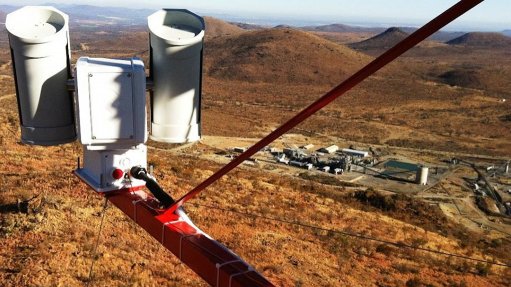
A WATCHFUL EYE High Site is made up of a network of thermal imaging cameras that are installed on the highest point of a mine site
Using new thermal-imaging camera systems in mine security vehicles and at the mine sites of a Pan-African gold mining company’s mines in Ghana and Tanzania has resulted in illegal mining incidents having decreased by more than 50% over the past three years.
The provider of these systems, turnkey security solutions provider SecuExport & SecuSystems MD Charles Harrison tells Mining Weekly that the technologies are two distinct systems, but are most likely to improve safety and security at mining operations when used in combination.
The company’s High Site containerised solution comprises a network of thermal-imaging cameras that are installed at the highest point of a mine site.
The solution further consists of several Flir CZ602 Series 9-km-range, 360º panning cameras, with day, night and thermal capabilities coupled with land movement target indicators, or LMTIs, and is the only analytical – Australian military developed – software that is capable of identifying human beings on a moving background.
“These cameras are installed onto a prefabricated mast that is attached to the top of the container, about 9 m from nominal ground level,” says Harrison.
He states that the container presents a physical security barrier to intruders and also ensures complete housing of all equipment needed for power reticulation, additional security systems and wireless equipment.
Harrison adds that the containers are fitted with their own power reticulation, including battery banks and solar panels, with the latter being mounted to the roof of the container.
He points out that the security systems, which are integrated into the camera solution, include wall-top fencing and/or additional free-standing electric fencing, with energisers operating off the internal power reticulation; external passive infrared detectors; and two high-powered pepper spray systems, which can either be programmed to trigger on activation of security systems or remotely detonated upon verification.
All sides of the container are installed with nozzles and high-pressure hydraulic piping.
The system allows for wireless communication to a centralised control room.
“The existing installations have more than 36 km of wireless link that allows for complete surveillance and control,” states Harrison.
The other system in use at the mines is SerVision’s MVG400 mobile digital video recording (DVR) system – a video compression technology for use on mining and security vehicles.
SecuExport & SecuSystems bought the MVG400 mobile recorders in 2012 from broadcast and security technologies supplier Graphic Image Technologies, the regional representative in Africa for the SerVision range.
Harrison explains that the MVG400 enables the streaming of live footage from four cameras, mounted in and around the mine vehicle, over 3G cellular or wireless connections using compression technology.
“This enables transmission of video at four frames per second at data rates as low as 8 KB/s,” he points out.
Harrison further highlights that SerVision also has fleet-management capabilities, as it records when diesel is siphoned off mine vehicles, using the system’s cameras.
“We have 18 vehicles that are equipped with SerVision technology in Ghana and Tanzania. This is the first application of this technology in Africa for the mining industry. Given the success of this solution, the client is now considering installing thermal-imaging cameras, along with the SerVision DVRs, on automated vehicles used in the mine to enhance safety measures,” he states.
Although SerVision is being used at the mines in Ghana and Tanzania, only the High Site solution is being used at the gold mine in Tanzania.